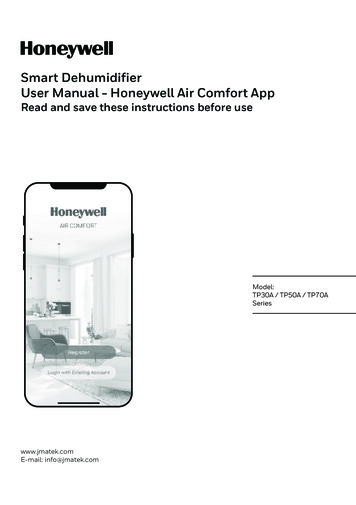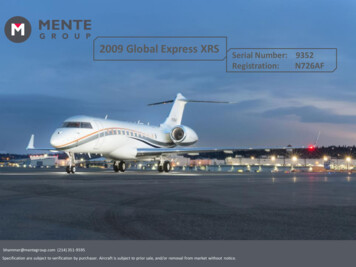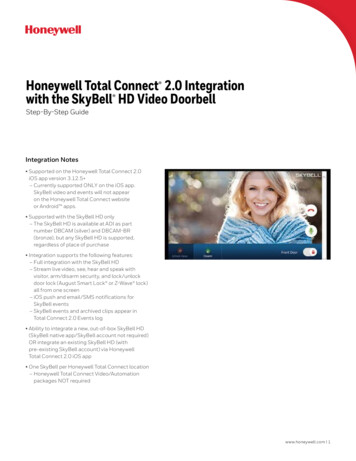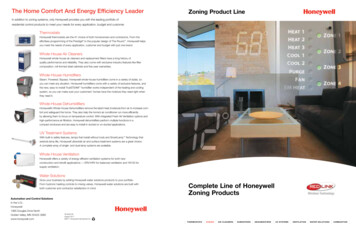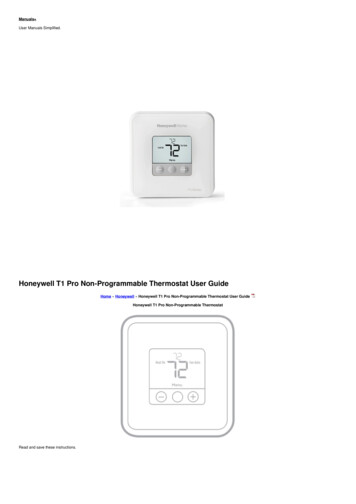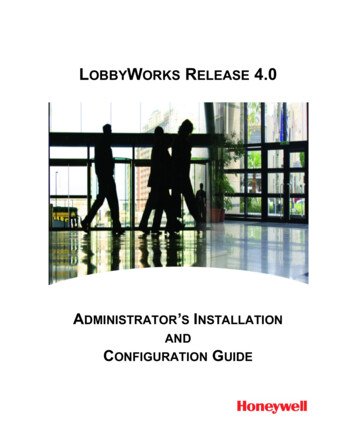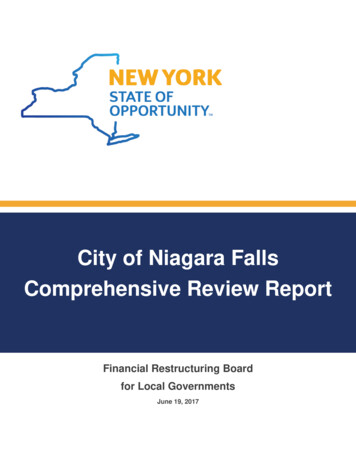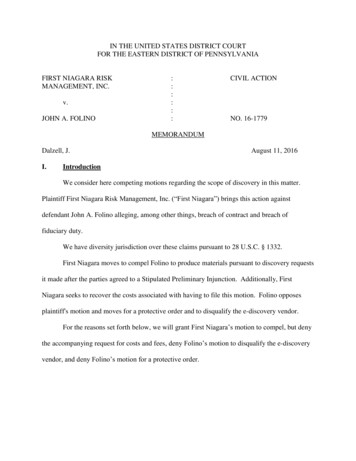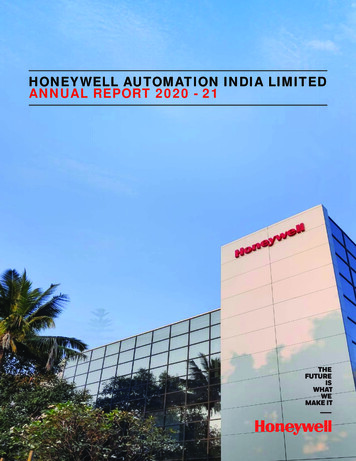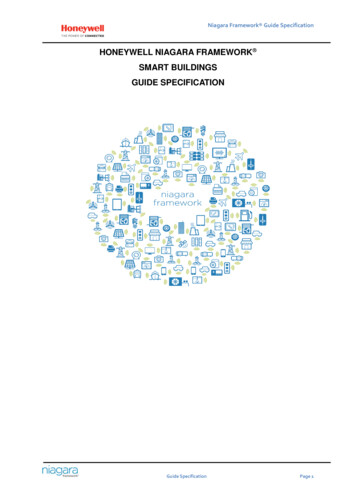
Transcription
Niagara Framework Guide SpecificationHONEYWELL NIAGARA FRAMEWORK SMART BUILDINGSGUIDE SPECIFICATIONGuide SpecificationPage 1
Niagara Framework Guide SpecificationGuide SpecificationPage 2
Niagara Framework Guide SpecificationINDEXDEFINITIONS . 52INTRODUCTION . 632.1PURPOSE & TARGET AUDIENCE . 62.2USE OF THIS GUIDE SPECIFICATION . 6SCOPE . 6NIAGARA FRAMEWORK IOT DATA STACK . 8NIAGARA FUNCTIONS & FEATURES . 93.2.1The Niagara Framework s Architecture supports: . 93.2.2Niagara N4 Features . 93.3MARKET PLACES . 93.4SMART BUILDING BENEFITS . 103.4.1On the Cloud Services . 10MIDDLEWARE . 103.13.244.15NETWORKS & FRAMEWORK INFRASTRUCTURE SCOPE . 114.1.1Niagara Platform Connectivity . 114.1.2Niagara Integration . 114.2OPEN PROTOCOL & DATA SECURITY . 12GENERAL SYSTEM DESCRIPTION . 1365.1MIDDLEWARE REQUIRMENTS . 135.2MIDDLEWARE INTERFACING . 13SMART BUILDING NIAGARA FRAMEWORK OVERVIEW . 146.16.26.36.46.56.66.7GENERAL . 14ARCHITECTURE. 146.2.1Systems Integration. 146.2.2Software Components . 166.2.3Enterprise Connectivity . 18FRAMEWORK ARCHITECTURE OVERVIEW . 186.3.1Network Infrastructure . 196.3.2Middleware Platforms & Management Level. 19NIAGARA FRAMEWORK OPERATIONAL REQUIREMENTS . 196.4.1Operating System & Security . 196.4.2Ports and Protocol Control . 20ACCESS AND PERMISSIONS. 216.5.1User Groups . 216.5.2Categories . 226.5.3Permissions. 226.5.4Authentication . 22SECURITY & DOMAIN INTERFACING . ERROR! BOOKMARK NOT DEFINED.6.6.1Domain Considerations . 22SOFTWARE & DATABASE BACKUP . 23Guide SpecificationPage 3
Niagara Framework Guide Specification7NIAGARA MANAGEMENT LEVEL REQUIREMENTS. 257.1GRAPHICS USER INTERFACE . 257.1.17.1.27.2USER INTERFACE (UI). 267.2.17.2.27.2.37.3Specific Graphical Requirements.26APPLICATION REQUIREMENTS . 277.4.17.4.27.4.37.4.47.5User Logon.26SPoG Landing Page .26Navigation Task Bar .26SYSTEM GRAPHICS DEVELOPEMENT . 267.3.17.4General .25Graphic Browser Navigation .25Schedules .27Alarm Handling, Notification and Management .28Histories .30Reporting .32ENTERPRISE SERVER & WEB BROWSER GUI . 337.5.17.5.2System Overview .33Niagara Middleware Server & Network Storage .33Guide SpecificationPage 4
Niagara Framework Guide llThe CompanyNiagaraFramework The Framework Architecture for Edge to Cloud technologyJACEJAVA Application Control EngineAPIApplication Programme InterfaceBaaSBackup as a ServiceESEnterprise ServicesFMFacilities ManagementFoxUnencrypted Niagara Framework intra-JACE communicationsFoxsEncrypted Niagara Framework intra-JACE communicationsGUIGraphical User InterfaceHTTPSHypertext Transfer Protocol SecureI/OInput OutputICTInformation Communications TechnologiesIoTInternet of ThingsIPInternet ProtocolLDAPLightweight Directory Access ProtocolM&EMechanical & ElectricalNASNetwork Attached StorageNICSNiagara Information Conformance StatementOEMOriginal Equipment ManufacturerOSAOpen Systems ArchitecturePaaSPlatform as a ServicePICSBACnet Protocol Implementation Conformance StatementPKIPublic Key InfrastructureRBACRole-Based Access ControlSaaSSoftware as a ServiceSI’sSystems IntegratorsSCADASupervisory Control and Data AcquisitionSPoGSingle Pain of GlassSSLSecure Socket LayerSVGScalable Vector GraphicsTLSTransport Layer SecurityUIUser InterfaceUPSUninterruptable Power SupplyVLANVirtual Local Area NetworkVRVVariable Refrigerant VolumeVSDVariable Speed DriveGuide SpecificationPage 5
Niagara Framework Guide Specification2INTRODUCTION2.1PURPOSE & TARGET AUDIENCEThis guide specification is aimed at Consultants, Developers and Interested Specifyingparties such as: Consultants Design & Build Contractors Developers Direct End Client / Users Middleware Specialists System IntegratorsThis specification serves as a guide to defining project specific requirements and becomesan outline to the deployment of the Niagara Framework Architecture, equipment andsolutionsThe aim is for specifying parties to create their own Smart Buildings specification from theoutline of this Guide specification which provides information and guidance on the NiagaraFramework components and how to deploy the Niagara Framework over multiprotocoled systems and IoT Edge devices.The output specification will need to incorporate the client’s specific requirements andsystems to be integrated, the target of this output should be Niagara Framework OEM,Resellers and SI’s who have the capability to deploy the required solution(s).This output specification should also be read in conjunction with other services systemspecifications and their requirements such as BMS, Electrical, Lighting, Mechanical, Fire,Security, FM Systems & Enterprise Systems2.2USE OF THIS GUIDE SPECIFICATIONThis Guide specification is offered in good faith and without prejudice; the responsibilityremains with the system designers to ensure that their project design intent is met. AnyInterested specifying partner can use this Guide Specification and relevant clauses inconjunction with their own specification and standards specification sections.3SCOPEThis Smart Buildings Guide specification outlines the Functions and Features of theNiagara Framework which can be deployed across any network connected systems,locally and remotely and accessible via the Internet via WEB Browsers over theIoT(Internet of Things).A Smart Building approach differs from a traditional building systems and servicesapproach where each M&E, Facilities and Enterprise systems are connected via their owninfrastructures, a Smart Building facilitates connectivity of any system over commoncommunications Infrastructure (Cabling, Network Infrastructure) using industry standardopen protocols and Application Programme Interfaces (API’s) allowing data to be sharedand manipulated to provide cause and effects between systems.Communications infrastructures can include client’s server environments (Server Farms)which are designed, supplied and installed by an Information and CommunicationsGuide SpecificationPage 6
Niagara Framework Guide SpecificationTechnology (ICT) and Cloud Specialist and includes/considers deployment of the followingcomponents parts which require separate scoping: Data Centres and Cloud Infrastructure Building Level Network Backbone Fibre/CAT6 cabling Infrastructure Active Network / Switch Infrastructure Direct Connectivity of Sub-Systems via IP Connectivity of Building, Corporate or Internet Software Services (SaaS) on the sameinfrastructure Data via “Middleware” platforms to allow data connectivity Logical Separation of Data Services (Building / Clients Services) via Firewalls / VirtualLocal area Networks (VLAN’s) Implementation of common Network Security / Management in line with Client Policies Virtualised Server \ Cloud Environments onto which all applications and services aredeployed from Common User Interfaces and Facilities Management OperationThis guide specification mentions the above but does not detail any design or deploymentrequirements, it will be the responsibility of the designer to ensure that the above areconsidered as part of an overall Smart Building delivery.Guide SpecificationPage 7
Niagara Framework Guide Specification3.1NIAGARA FRAMEWORK IoT DATA STACKBuilding Services Technologies and Systems Data Integration can provide manypossibilities and benefits for system data to be connected to allow inter-process controland interaction as well as providing common management level visualisation andoperation via Desktops and Mobile devices.There are different levels of integration available depending on the various systems,services and applications, the Niagara Framework is architected around the IoT andtakes the form of the following:This is a representation of a typical IoT solution with the many layers required to get datafrom many disparate systems and IoT devices to either a Desktop User Interface (UI) I orMobile device through the IoT Layer Stack.The Niagara Framework supports device and data connectivity across all layers of theNiagara Framework Honeywell are developing Niagara down to the Edge with Micro andLite versions to facilitate applications at the Edge of the IoT layer stack.Guide SpecificationPage 8
Niagara Framework Guide Specification3.2NIAGARA FEATURES & FUNCTIONSThe Niagara Framework facilitates an Open, no lock-in framework architecture allowingmulti-vendor systems and solutions to be connected and supported by a community ofSystems Integrators and Developers, allowing clients freedom of choice to either retainexisting systems and infrastructures or to upgrade in the future using the latesttechnologies and infrastructures. The Niagara Framework was designed to allowintegrators and developers to connect, manage, and control any device, regardless ofmanufacturer, using any protocol.3.2.1The Niagara Framework s Architecture supports: Cloud Deployment Enterprise Systems & Services Facilities & Asset Management Services Visualisation, Alarming, History, Reporting Applications On-Premises Deployment IoT and Connectivity of Edge Devices IoT Apps Customizable Security Controls to meet Organization Security Policies 3.2.23.3Niagara N4 Features Structured / Relational Tagging Templating Analytics User Interfaces IT Compliance Built-in Cyber Security Controls for Confidentiality, Integrity, Authentication,Authorization, Auditing, and Malware prevention.MARKET PLACESThe Niagara Framework is a flexible and extensible IoT framework that can supportmany business domains, it facilitates multi-disciplined Systems connectivity, and canprovide solutions in the following sectors: BMS / HVAC (Plant Level) Security (CCTV/ACCESS) Lighting / Blinds AV Fire Elevators Home Automation Energy Management Electrical Management Building Performance and MonitoringGuide SpecificationPage 9
Niagara Framework Guide Specification3.4 Facilities Management Data Centres (DCIM) Renewables Demand Side Response Bureau Management Smart DevicesSMART BUILDING BENEFITSBenefits when adopting a “Smart Building” approach on the Niagara Framework couldinclude any of the following value propositions:3.4.1 Open, no lock in to a specific manufacturer, freedom of choice in future systemupgrades Backup as a Service (Baas) included. Extensible and flexible – can be extended to support any device and protocol, allowingowners to adjust as technology changes Browser Based User Interface and visualisation using HTML 5, no Browser Pluginrequired All open protocols included as standard e.g. BACnet, KNX, LON, M-Bus, Modbus,oBiX, SNMP etc. Can be used with Multiple Protocols on one platform, e.g. JACE or Server, either openand/or legacy types providing cost effective integration JACE 8000 can be supplied with or without Wi-Fi on Board option. Native built in Analytics at Platform and Supervisor Levels One WEB Based Software engineering tool for Integration, Visualisation, CyberSecurity, Enterprise data exchange and analytics.On the Cloud ServicesThe Niagara Framework also facilitates following: Browser based engineeringFlexible secure access either locally and/or remotely Cyber Security capabilities that provide strong authentication, role-based authorisation,encrypted communications, encrypted sensitive information at rest, digitally-signedcode validated at run-time, and auditing – customisable for meeting the Cyber Securitypolicies of any organization Real time Cloud Based information for better business decisions Lower total cost of ownership Opportunity to improve business processes Savings in Operational managementAutomation and Optimisation of Systems and Processes MiddlewareGuide SpecificationPage 10
Niagara Framework Guide Specification3.5NETWORKS & FRAMEWORK INFRASTRUCTURE SCOPEThe section outlines the Niagara Framework and Middleware JACE platforminfrastructure concept required to connect and gather date from multiple data sources andservices to handle and manage data across multi-disciplined systems.3.5.1Niagara Platform ConnectivityWhere systems and application require serial data and/or TCP/IP connectivity, these canbe accommodated concurrently via the JACE Platform.3.5.2 BACnet / RS485 / TCP/IP Dali / RS485 / TCP/IP LON / TCP/IP KNX / RS485 / TCP/IP M-Bus / RS232 / TCP/IP Modbus / RS485 / TCP/IP oBIX / TCP/IP SNMP /TCP/IPNiagara IntegrationBuilding Services Systems Data can be “Integrated” at many levels: Hardwired between different systems Input/Outputs to provide C&E functionality High Level Integration at the Automation Level using Manufactures own developedGateways and Protocols High Level Integration at the Automation Level using 3rd Party Integration Platforms High Level Integration between Automation and Management Levels using Gateways Management Level via SQL / oBIX Data Exchange (Many Systems still use FileTransfer) Integrated Data may then be used to display data on the SPoG via Graphical UserInterfaces and automated control interaction between Systems (Cause & Effect) It should also be mentioned that the Niagara Framework is a completely extensibleopen platform. Using our open APIs, any Niagara developer can write a softwaremodule to support any new protocol or device, providing flexibility in enterpriseintegration.Guide SpecificationPage 11
Niagara Framework Guide Specification3.6OPEN PROTOCOL & DATA SECURITYTo facilitate secure deployment of Software Services (SaaS) utilising NiagaraFramework during Smart Building deployment and as part of any future IoT deploymentrequirements, all connected systems and services shall comply with the followinginterfacing & security requirements: Support of IT / Networking Industry Standard Open Protocols and IP Connectivity at alllevels of each System / Product Architecture including Enterprise Level licensing andSQL / Enterprise interfacing. Support of Windows / Linux RHEL Operating Systems Support of Open Standard Services Protocols over Ethernet/IP or Serial Networks forMiddleware deployment. Support of Object data types over Niagara Framework such as Analogue and BinaryInput/Outputs, Internal Calculated Values, Set points, Alarms (IncludingAcknowledgements and Resets), Time Schedule Objects and Trend Log Objects whichshall all be available for Middleware Platform data Integration and automation as wellas Management Level Visualisation and Operation Where BACnet Systems are deployed either at the Platform or Supervisor levels, theProtocol Implementation Conformance Statement (PICS) Statements for eachconnecting system shall be used to verify compliance. Where other industry standard and Open protocols (Modbus, KNX, LON, SNMP) areutilised for integration with the Niagara Framework , then each connecting party shallproduce a generic interfacing compliance statement with a full list of all available dataobjects and supported functionality, including whether they are Read and/or Write, anda detail description of there addressing schemes. All Niagara systems shall be configured in accordance to the Niagara 4 HardeningGuide. Niagara Framework comes with a significant number of configurable CyberSecurity capabilities, such as strong authentication, Role-Based Access Control,encrypted communications, encryption at rest, security auditing, and provides theability for integrators to customize security based on their security policies. Role-Based Access Control (RBAC) shall be deployed, making user permissions easyto configure and less error-prone. All user actions and security-related events shall berecorded in Niagara’s audit log for traceability. Any 3rd Party system to be connecting into the Niagara Framework onto a SmartBuilding solution, must have an End of Life (EoL) statement outlining the long term lifecycle plan, and ongoing product support plan.Guide SpecificationPage 12
Niagara Framework Guide Specification4GENERAL SYSTEM DESCRIPTION4.1MIDDLEWARE REQUIRMENTSA physical Middleware comprising of Niagara Framework Platforms shall be deployedproviding an interfacing data layer between any 3rd-party systems which shall providedistributed processing as well as normalised data into Niagara Objects, the middlewareshall comprise of:4.2 Platforms which shall be housed within dedicated enclosures or racks as required bythe project requirements Deployment of Overarching Management Level using Niagara N4 Server withoverarching Single Pain of Glass (SPoG) to provide a Graphical User Interface, MultiSystem Navigation from Landing Page with ability to simply navigate and individualsystem/plant page graphics using N4 Navigation Setup and configuration of stations in accordance with the Niagara Hardening Guide. Structured Tagging, Templating, Analytics and “Cause & Effect” functionality asrequired to provide SPoG design requirements. The middleware shall comprise of: Multi System Alarm Management, Handling and ReportingMIDDLEWARE INTERFACINGThe Middleware and its associated Management Systems shall comprise of a numberNiagara Platforms distributed throughout the facility to suit interfacing requirements to: Access Control Systems Automated Demand Response (ADR) Audio Visual (AV) Combined Heat & Power (CHP) Building Management Systems (BMS / HVAC) Closed Circuit Television (CCTV) Elevators Energy Monitoring & Management Systems (EMS) Escalators Enterprise Facility Management Fire Alarm Heat Pumps Lighting Pumps Renewable Power Systems (e.g. Solar PV, Wind Turbines, Battery Storage) SCADA/PLC (Electrical HV/LV Switching) Signage Uninterruptable Power Supplies (UPS) Variable Speed Drives (Inverters)Guide SpecificationPage 13
Niagara Framework Guide Specification Variable Refrigerant Volume Systems (VRV)5SMART BUILDING NIAGARA FRAMEWORK OVERVIEW5.1GENERALThe Smart Building system shall be based on a design for an Open Systems Architecture(OSA) within a multi-user, multi-tasking environments allowing for simultaneous access bymultiple users and distributed network interfacing to provide connectivity to multiple subsystems via the Internet / cloud.Data exchange shall be facilitated by utilising the Niagara Framework as a “Middleware”to interface with Open and proprietary 3rd party systems over the Common NetworkInfrastructures and to present data into an overarching Management Level System viaHTML 5 and Visualisation using Niagara N4The N4 architecture shall be based on a scalable framework to accommodate any changesin data usage and connectivity within the buildings and their systems to meet with anyfuture requirements, thus future proofing client’s investment into Smart Buildings Systems,infrastructures and services.5.2ARCHITECTURE5.2.1Systems IntegrationThe Smart Building Middleware system shall be based on the Niagara N4 Frameworkarchitecture, designed around open and secure communications standards using HTML5WEB technology.The Middleware shall have the capability to communicate via multiple industry openprotocols running over Building Network Infrastructures and computer networks, theNiagara Framework provides support for the following protocols as standard: BACnet LonWorks KNX/EIB Modbus M-Bus oBIX OPC SNMP HTTP (HTML 5 / XML Mark-up Languages) Niagara (FOXS)Once any subsystem are integrated into the Niagara Framework via JACE Platforms toform a distributed middleware layer, the associated system data point objects shall then benormalised into the Niagara Framework objects for data manipulation, alarming andvisualisation requirements.Guide SpecificationPage 14
Niagara Framework Guide SpecificationThe Middleware shall provide the capability to allow Open development of specificsolutions or any 3rd Party drivers or Applications (Apps) to meet current or futurerequirements and to connect to IoT Services, subject to meeting Honeywell’s CertificationProgramme (TCP) Niagara Certified Training (N4, Analytics and Development).Where communications with 3rd Party systems do not conform to any of the Industry Opencommunication standards and utilise proprietary protocols and networks, they shall beintegrated via Niagara Platforms using 3rd party communications drivers if available (Referto Latest Honeywell Driver List), or a 3rd Party drivers developed specifically to meetrequirements.The Middleware Server shall provide access to the 3rd Party systems via HTML5compatible Browsers over the Network Infrastructures using Niagara N4 Graphics whichshall require no special software, e.g. ActiveX components or JAVA Plugins to be installedon to the Client PC’s or any other user interfaces (UI’s).Niagara stations shall be configured in accordance with the Niagara Hardening Guide.Communication between the HTML Web Browser UI’s and Middleware Server shall besecured via encryption using 128-bit encryption technology within Secure Socket Layers /Transport Layer Security (TLS/SSL) over HTTPS.In order to protect the Cyber Security of all connected systems, Niagara Systems shall notbe directly exposed on the Internet. If remote access to these systems is required, Niagarasystems can be protected by a VPN gateway, providing security protection. Keepingstations behind a properly configured VPN ensures that they are not exposed, reducingthe system’s attack surface. For more information, see “Using a VPN with NiagaraSystems” available from the Niagara Framework Software Security Resource Center onNiagara Community.As part of the Middleware deployment requirements Niagara N4 Server Software shall besetup to operate on its own dedicated Server environment but shall have the capability tooperate under a Virtual server environment if required.The Niagara framework architecture shall provide Operator(s) complete access to theMiddleware system via HTML5 WEB browsers, both operationally and also for engineeringrequirements via Niagara Software Engineering Tools (Workbench).The functionality provided through the HTML5 Browser interface shall be not altered, orrestricted, based on the location, or type of device used to access the system, the onlyapplicable restrictions shall be those associated with each individual Roll based Accessbased on their Login credentials.Niagara Information and Conformance Statement (NICS)The Niagara Compatibility Statement (NICS) for all Niagara Software shall allow open accessand be set as follows: accept.station.in "*" accept.station.out "*" accept.wb.out "*"accept.wb.in "*”. In any case, the End User shall maintain the right to instruct the contractorto modify any software license, regardless of supplier, as desired by the End User. TheContractor shall not install any “brand specific” software, applications or utilities on NiagaraFramework based devices.Guide SpecificationPage 15
Niagara Framework Guide SpecificationAll hardware and field level devices installed, shall not be limited in their ability tocommunicate with a specific brand of Niagara Framework JACE. They shall also beconstructed in a modular fashion to permit the next generation and support components tobe installed in replace of or in parallel with existing components.At the completion of the project the owner shall be given all existing platform and station login credentials to include; Super User (Admin) user names; passwords and passphrases.The HTML5 WEB browser User Interface (UI) shall be completely interactive and providethe following functionality as a minimum:5.2.2 Single Pain of Glass (SPoG) Visualisation and access to all Systems Alarm / Event information Real-Time Graphics Browser Based Navigation of Systems & Graphics Trending (Data Historian) Time Scheduling Analytics Control Logic Definitions (Wire Sheets) Parameter/Setpoints and Override Adjustment Client Alarm Popup and Annunciation Single Tool for Live Software & Graphics Engineering Platform / Station Configuration & MaintenanceSoftware ComponentsThe Niagara Framework architecture shall provide a Middleware layer which is fullyextensible and scalable to meet any future expansion or enhancement requirements. TheMiddleware shall also facilitate Enhanced Cause and Effect between systems which canbe designed, delivered and commissioned via TCP Trained Niagara Specialists.Guide SpecificationPage 16
Niagara Framework Guide SpecificationAll components of the Middleware software shall be configured, setup and completed inaccordance with the required specifications, software components shall include: Server Software including latest Operating System (Windows or Linux RHEL) Niagara N4 Core Software and Licenses Single WEB based Application & Tools (Workbench) Graphical Programming Tool Control Logic Software Tool Application Software (Alarming, Trending, Time Scheduling, Logging) AnalyticsGuide SpecificationPage 17
Niagara Framework Guide Specification5.2.3Enterprise ConnectivitySubject to licensing and requirements, the Enterprise Management Level shall allow realtime Connectivity of data via any of the following accepted methods: SQL (Structured Query Language) OPC (Object Link Embedding for Process Control) oBIX (Open Building Information eXchange) SNMP (Simple Network Management Protocol) API (Application Programme Interface)Whilst still employed a common means of transferring data, Simple Text file transfer e.g.Comma Separated Value (CSV) mechanisms are not recommended as part of the OpenSystem Architecture requirements as this are inherently prone to failure and data loss,oBIX (XML) and API based data transferred are the recommended data transfer methodsinto Niagara.5.3FRAMEWORK ARCHITECTURE OVERVIEWThe Framework shall be based on a distributed architecture with real time data access viaopen industry protocols providing WEB based engineering capability and Systemmonitoring and management of the connected subsystems data at multiple levels oversecured networks and infrastructures: Cloud Enterprise EdgeThe Honeywell JAVA Application Control Engine (JACE) shall be deployed to providepeer-to-peer connection and Edge device connectivity, allowing subsystem devices tocon
JACE JAVA Application Control Engine API Application Programme Interface BaaS Backup as a Service ES Enterprise Services FM Facilities Management Fox Unencrypted Niagara Framework intra-JACE communications Foxs Encrypted Niagara Framework intra-JACE communications GUI Graphical User Interface HTTPS Hypertext Transfer Protocol Secure


